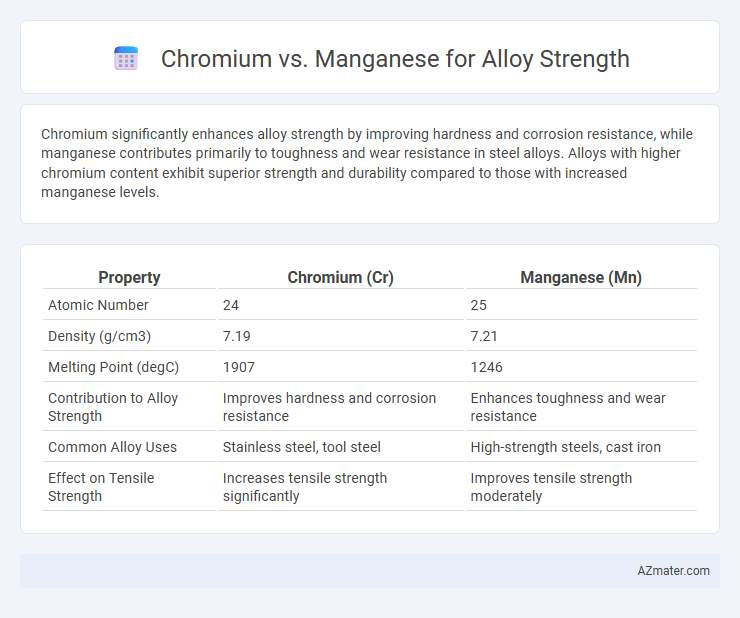Chromium significantly enhances alloy strength by improving hardness and corrosion resistance, while manganese contributes primarily to toughness and wear resistance in steel alloys. Alloys with higher chromium content exhibit superior strength and durability compared to those with increased manganese levels.
Table of Comparison
| Property | Chromium (Cr) | Manganese (Mn) |
|---|---|---|
| Atomic Number | 24 | 25 |
| Density (g/cm3) | 7.19 | 7.21 |
| Melting Point (degC) | 1907 | 1246 |
| Contribution to Alloy Strength | Improves hardness and corrosion resistance | Enhances toughness and wear resistance |
| Common Alloy Uses | Stainless steel, tool steel | High-strength steels, cast iron |
| Effect on Tensile Strength | Increases tensile strength significantly | Improves tensile strength moderately |
Comparative Overview: Chromium vs Manganese in Alloys
Chromium enhances alloy strength by increasing hardness, corrosion resistance, and wear resistance, making it essential in stainless steels and high-performance alloys. Manganese contributes primarily to toughness and ductility, improving impact resistance and reducing brittleness in low and medium carbon steels. Compared to manganese, chromium provides superior oxidation resistance and hardness, while manganese excels in improving machinability and fatigue strength in alloys.
Chemical Properties and Reactivity
Chromium exhibits high corrosion resistance and forms a stable oxide layer, enhancing alloy durability and hardness, making it essential in stainless steel production. Manganese, with its strong affinity for sulfur and oxygen, improves toughness and wear resistance by reducing brittleness and refining grain structure in alloys. The chemical reactivity of chromium favors passivation, while manganese's role as a deoxidizer and sulfur fixer is critical for controlling impurity effects in metal matrices.
Impact on Alloy Microstructure
Chromium refines grain size and promotes the formation of stable carbides, enhancing the alloy's hardness and resistance to wear. Manganese acts as a deoxidizer and combines with sulfur to form manganese sulfides, improving toughness and ductility. The interplay of chromium and manganese in the microstructure determines the balance between strength and impact resistance in steel alloys.
Influence on Tensile and Yield Strength
Chromium enhances alloy tensile strength by improving hardenability and resistance to deformation under stress, leading to higher yield points and improved wear resistance. Manganese contributes significantly to tensile strength through its role in deoxidizing steel and increasing hardenability, resulting in improved toughness and ductility. Alloys with optimized chromium and manganese levels exhibit balanced yield strength and tensile strength critical for structural applications requiring durability and resistance to mechanical stress.
Corrosion Resistance: Chromium vs Manganese
Chromium significantly enhances corrosion resistance in alloys by forming a passive oxide layer that protects the metal from oxidation and rust. Manganese contributes to alloy strength by improving hardenability and tensile strength but offers limited corrosion resistance compared to chromium. Alloys with higher chromium content are preferred for environments requiring superior resistance to corrosion, especially in stainless steel applications.
Effects on Hardness and Wear Resistance
Chromium significantly enhances alloy hardness by increasing surface hardness through the formation of chromium carbides, which improve wear resistance and corrosion prevention. Manganese contributes to tensile strength and toughness but has a less pronounced effect on hardness compared to chromium. Alloys with higher chromium content typically demonstrate superior wear resistance and longer service life in abrasive environments.
Role in Heat Treatment Processes
Chromium significantly enhances alloy strength by forming hard carbides and promoting hardenability during heat treatment processes, resulting in improved wear resistance and toughness. Manganese contributes to alloy strength by acting as a deoxidizer and stabilizing austenite, which facilitates uniform microstructure development during quenching and tempering. Both elements play crucial roles in heat treatment, with chromium providing increased hardenability and manganese ensuring structural stability and improved impact resistance.
Alloying Cost and Resource Availability
Chromium enhances alloy strength and corrosion resistance at a moderate alloying cost, benefiting from abundant global reserves that ensure steady supply and pricing stability. Manganese contributes significantly to tensile strength and hardness with lower cost implications, supported by widespread availability, especially in major mining regions like South Africa and Australia. Balancing strength improvements with economic efficiency often involves optimizing the chromium-manganese ratio to leverage cost-effective resource accessibility.
Key Industrial Applications
Chromium significantly enhances corrosion resistance and hardness in stainless steel alloys, making it essential in automotive, aerospace, and construction industries. Manganese improves toughness and wear resistance in steel, crucial for heavy machinery, rail tracks, and structural engineering. Both elements optimize alloy performance, with chromium prioritized for environmental durability and manganese for impact strength in industrial applications.
Choosing the Right Element for Alloy Strength
Chromium enhances alloy strength by increasing hardness, corrosion resistance, and wear resistance, making it ideal for stainless steels and high-performance tooling. Manganese improves tensile strength and toughness, also aiding in deoxidation during steel production, which enhances overall alloy durability. Selecting chromium is preferable for corrosion-resistant applications, while manganese is better suited for improving mechanical properties in structural steels.

Infographic: Chromium vs Manganese for Alloy Strength
 azmater.com
azmater.com